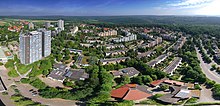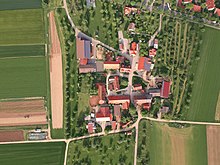Forest houses east
|
Forest houses east
District of Tübingen
Coordinates: 48 ° 32 '38 " N , 9 ° 3' 34" E
|
|
|---|---|
| Height : | 379 m above sea level NN |
| Residents : | 4785 (Dec. 31, 2007) |
| Postal code : | 72076 |
| Area code : | 07071 |
|
Tübingen-Waldhäuser Ost
|
|
Waldhäuser Ost is a district of the university town of Tübingen . It is located north of the city center and was built next to the hamlet of Waldhausen , which already belonged to Tübingen and is now part of the Wanne district .
location
Waldhäuser Ost (short: WHO ) is the highest district on the northern outskirts and is located on a slightly inclined hill. The western boundary to the Wanne district is Waldhäuser Strasse and the southern boundary to the Schönblick / Winkelwiese district is the Nordring . The WHO student village is bordered by the Berliner Ring and Waldhäuser Straße . Together with the latter two areas, WHO forms the district with the order number 014.
In the north, below the steep drop of the Geißhalde, the district of Bebenhausen joins.
WHO is well connected to public bus transport. During the day, the buses sometimes run to the center every 5 minutes. Night bus routes run every weekday.
Due to its location on the outskirts of the city, WHO offers a wide range of sports. A large indoor swimming pool, several sports fields for foot and basketball, riding facilities and forest sports trails that are suitable for jogging or biking tours are all within easy walking distance. Hikes in the Schönbuch can also be started here.
structure
The settlement is a typical residential block and high-rise estate from the 1960s and 1970s. The tallest skyscrapers in Tübingen are located here. The district is crossed by a large, circular street, the Berliner Ring . Side streets branch off at right angles to it. They are named after trees and alphabetically arranged counterclockwise , with the Fichtenweg being an exception. This is located between the Weißdornweg and the Ahornweg. The largest skyscraper in the center of WHO (Weißdornweg 14) houses around 400 people.
Also in the center is a primary school and the Geschwister-Scholl-Schule and on the northern edge the Tübingen Free Waldorf School , a comprehensive school . The Geschwister-Scholl-Schule is a former integrated comprehensive school that houses a secondary school , a secondary school and a grammar school in shared buildings that were renovated between 2003 and 2007 and has been a cooperative comprehensive school since the 1984/85 school year. The Winkelwiese / Waldhäuser Ost primary school consists of two departments, one of which is WHO and the other in the Schönblick / Winkelwiese district. At the edge of the settlement there are more and more tranquil terraced houses and apartment buildings, some with gardens.
There is a shopping center, an indoor swimming pool (Hallenbad Nord) with sauna, the Protestant Dietrich Bonhoeffer church with a Marc Garnier organ, two youth clubs , several restaurants as well as a café, a bar and a snack bar. The 50-meter-high Tübingen water silo in Tannenweg is an unusual structure , as it is directly connected to a high-rise building and looks as if it were part of it - in fact, the structures do not touch. There are several childcare facilities on WHO from various providers (municipal, denominational; student union, etc.).
history
In the description of the Oberamt Tübingen from 1867 there is a section " Bebenhausen with Waldhausen " at Tübingen : The agriculture in Waldhausen (compared to Bebenhausen) is "relatively important" (spelled and barley; a lot of three-leaf clover and reps ; cattle breeding) . WALDHAUSEN lawn 1 / 4 hour south of Bebenhausen on the high level, "the population of form 5 wealthy farming families". A town chronicle of Tübingen mentions a large parade ground near Waldhausen for 1901 . The hamlet is first mentioned in a document in 1105.
Due to the expansion of the university town of Tübingen in the 1960s, the construction of the Waldhäuser Ost district began in 1968 on the former parade ground near the aforementioned farm estate. In 1974 there were already 3,500 people living there. The settlement was originally designed primarily for doctors and hospital staff as well as students in order to counteract the housing shortage in Tübingen. In August 2004, one of the shopping center's two supermarkets burned out, and it was only opened again in March 2005.
See also
Individual evidence
- ↑ Source: The organ of the Dietrich Bonhoefferkirche in Tübingen by Marc Garnier
- ↑ Description d. Oberamts Tübingen / Chapter B 3 Digital full-text output in Wikisource
- ^ Tübingen from 1900 , Tübingen in portrait / city history; (This is next to the note about the inauguration of the new Neckar bridge and about the new high school down in town)






